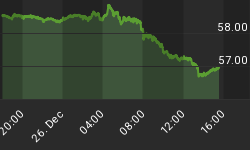As equities moved into their January highs, a very short-term Dow theory non-confirmation developed. The Transports made their January closing high on January11th at 4,262.86 while the Industrials pressed higher marking their January closing high 5 trading days later at 10,725.43. On March 9th the Transports closed above their January high and this time around the Industrials have lagged. As a result, we now have another Dow theory non-confirmation that spans a couple of months in duration. It seems that this latter non-confirmation is getting some attention. I received several e-mails and was forwarded several articles about this and quite frankly I find it amusing how people seem not only to want to pick and choose when they think Dow theory has merit, but also its meaning.

I have noted the very short-term Dow-theory non-confirmation surrounding the January top in blue and the more recently formed longer-term non-confirmation in red on the chart above. It seems that the spirit of the e-mails and articles I've received suggest that as a result of this non-confirmation, the market is now in immediate trouble. That is not necessarily the case and anyone that reads that into this non-confirmation at this time is in error. Yes, it is true that many market tops and bottoms historically occur in conjunction with Dow theory non-confirmations. It is also true that these non-confirmations serve as warnings. Therefore, it would also be a mistake to ignore or to not take this non-confirmation seriously. But, at the same time, we do not yet know what the Industrials won't better their January closing high and if so, this non-confirmation that seems to have gotten so much attention will no longer exist. So, my point here is to warn those that are jumping to conclusions just because one average beat the other one back above its previous closing high. Now, if the averages begin to breakdown from this point and it becomes much more apparent that this non-confirmation is going to stand, then at that time it will serve to give more merit to any such downturn. Until such time, this non-confirmation should be kept in perspective. This is only a warning of caution and is not an automatic death sentence to the market. It is what develops from here that will serve to validate or invalidate this non-confirmation.
Now, that all being said, the orthodox Dow theory primary bullish trend change that occurred in conjunction with the advance out of the March 2009 low still remains intact. However, it is very important to understand that this bullish primary trend change continues to operate within the context of a much longer-term secular bear market in accordance with Dow theory phasing. Dow theory phasing is a concept that very few understand because they have not read the original writings of our Dow theory founding fathers. This is also why most people who comment on Dow theory really don't understand what they are saying or they misinterpret the meaning of Dow theory, but that's another story. It was E. George Schaefer, the great Dow theorist of the 1950's and 60's who first realized that bull and bear market periods had evolved from the early days of Dow theory. Back in the days of Charles Dow, William Peter Hamilton and Robert Rhea, the bull and bear market periods were much shorter in total duration. In those days when a primary trend change occurred it marked the end of the old secular trend and the beginning of a new one. But, since 1921 these secular bull and bear market periods have grown in duration. It was during many of the corrections of the 1950's and early 1960s that Mr. Schaefer actually warned his subscribers about the error of the traditional "Rhea Schooled Dow theorists." Reason being, they did not recognize that these bull and bear market periods had grown and there were several corrections during that time frame that signaled primary bearish trend changes. But, because Mr. Schaefer understood what was occurring, he was able to realize that these trend changes were happening within the context of a much longer-term secular bull market. Mr. Schaefer used his so-called 200 day investment line, his 50% principle, the yield curve, values, and Dow theory phasing in order to give him a complete picture. As a result, Mr. Schaefer got it right.
My point here is that we are dealing with the exact opposite situation that Mr. Schaefer dealt with. In our case, we have a long-term secular bear market at play and the orthodox Dow theory bullish trend change that followed the March 2009 low is a bullish move within the context of that longer-term secular bear market and to date there have been no developments to change this view.
I have begun doing free Friday market commentary that is available at www.cyclesman.info/Articles.htm so please begin joining me there. The specifics on Dow theory, my statistics, model expectations, and timing are available through a subscription to Cycles News & Views and the short-term updates. I have gone back to the inception of the Dow Jones Industrial Average in 1896 and identified the common traits associated with all major market tops. Thus, I know with a high degree of probability what this bear market rally top will look like and how to identify it. These details are covered in the monthly research letters as it unfolds. I also provide important turn point analysis using the unique Cycle Turn Indicator on the stock market, the dollar, bonds, gold, silver, oil, gasoline, the XAU and more. A subscription includes access to the monthly issues of Cycles News & Views covering the Dow theory, and very detailed statistical based analysis plus updates 3 times a week.
















